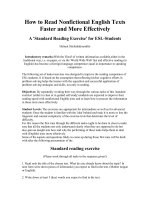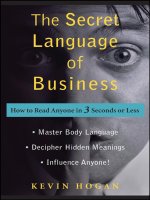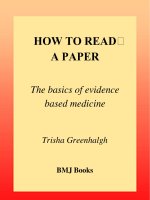how to read science a
Bạn đang xem bản rút gọn của tài liệu. Xem và tải ngay bản đầy đủ của tài liệu tại đây (25.25 MB, 330 trang )
xx
Sequence
The order in which events happen is the sequence of those
events. Sequence can also mean the steps we follow to do
something.
• You might
observe a sequence. Clue words such as first, then,
next, and finally also can help you find the sequence of events.
• Some events take place at the same time. Clue words such as
while, meanwhile, or during signal this.
Read the public message below. Clue words have been
highlighted to help you identify the order in which things happen.
Public Message
People save lives every day by donating blood.
First, you must fill out a questionnaire. These
questions make sure that it is healthy for you
to give blood and that your blood is safe to give
others. People with certain diseases or who take
certain medications cannot give blood. Next, if you meet all the
requirements, a health care professional removes a unit of blood.
Then, some of the blood is sent to be tested. Finally, your blood is
given to a person who needs it.
Apply It!
Make a graphic organizer like the one
shown. Observe the steps for donating
blood in the message above. Then write
the sequence of steps in the correct boxes.
61
First:
Next:
Next:
Last:
Help Save Lives!
Target
Reading Skill
Each page
has one target
reading skill.
The reading skill
corresponds with
a process skill
in the Directed
Inquiry activity
on the facing
page. The
reading skill will
be useful as you
read science.
Real-World
Connection
Each page has
an example of
something you
might read. It
also connects
with the Directed
Inquiry activity.
Graphic
Organizer
A useful strategy
for understanding
anything you
read is to create
a graphic
organizer.
A graphic
organizer
can help you
think about the
information and
relate parts of
it to each other.
Each reading
skill has a
certain graphic
organizer.
A page like this one is toward the beginning of each chapter.
It shows you how to use a reading skill that will help you
understand what you read.
Before Reading
Before you read the chapter, read the Build Background page
and think about how to answer the question. Recall what you
already know as you answer the question. Work with a partner
to make a list of what you already know. Then read the How
To Read Science page.
1. Describe how the respiratory and circulatory
systems work together.
2. Identify common diseases or disorders of the
respiratory system and their causes.
3.
Sequence What is the order of structures
that oxygen passes through between your nose
and bloodstream?
73
From the air sacs, oxygen
passes into the blood of
the capillaries. At the same
time, carbon dioxide goes
from the blood into the
air sacs. After these gases
switch places, the air moves
out of the lungs.
The arteries that go
from the heart into
the lungs branch into
smaller and smaller
blood vessels. The
tiniest blood vessels
are capillaries
around the air sacs.
Air sacs have very thin
walls. Around the wall of
each air sac is a web of
capillaries.
Air sacs
Blood vessels
Capillaries
Air Sacs in the Lungs
These capillaries are
magnified about
250 times.
Oxygen
Carbon dioxide
85
Sequence
14. Make a graphic organizer like the one
shown below. In the boxes, write, in
order, the parts of the respiratory system
through which inhaled air passes.
Test Prep
15. What is the kidney?
Ꭽ an organ that cleans the blood
Ꭾ a structure that keeps blood flowing
through the heart
Ꭿ the place where carbon dioxide leaves
the bloodstream
൳ an organ where food is stored
16. What structures connect the smallest
arteries with the smallest veins?
൵ air sacs
൶ capillaries
൷ bronchial tubes
൸ valves
17. Which organs make digestive fluids?
Ꭽ esophagus, stomach, small intestine,
and large intestine
Ꭾ esophagus, pancreas, liver, and
large intestine
Ꭿ stomach, small intestine, pancreas,
and large intestine
൳ stomach, pancreas, and liver
18. Which of these systems does NOT carry
waste out of the body?
൵ circulatory
൶ respiratory
൷ digestive
൸ urinary
19. Explain why the answer you selected
for Question 18 is best. For each of the
answers you do not select, give a reason
why it is not the best choice.
20.
Descriptive
Write a description of how the structure
of the teeth helps them do their job in the
digestive system.
Bronchial tubes
Bronchi
Trachea
Nose
Air sacs
Larynx
xxi
After Reading
After you have read the chapter, think
about what you found out. Exchange
ideas with your partner. Compare
the list you made before you read
the chapter with what you learned
by reading it. Answer the questions
in the Chapter Review. One question
uses the reading target skill.
During Reading
As you read the lesson, use
the checkpoint to check your
understanding. Some checkpoints
ask you to use the reading
target skill.
These are the target reading skills and graphic organizers that appear in this book.
Cause and Effect Draw Conclusions
Compare and Contrast Summarize
Sequence Main Idea
Predict
and Details
Graphic Organizers
xxii
xxiii
xxiv
xxv
What material is
best for keeping
heat in water?
Ask a question.
You might have a question
about something you observe.
State your hypothesis.
A hypothesis is a possible
answer to your question.
If I wrap the jar in fake
fur, then the water will
stay warmer.
Identify and
control variables.
Variables are things
that can change. For
a fair test, you choose
just one variable to
change. Keep all other
variables the same.
Test other materials. Put the same
amount of warm water in other jars
that are the same size and shape.
Scientists use scientific methods as they work. Scientific methods are
organized ways answer questions and solve problems. Scientific methods
include the steps shown here. Scientists might not use all the steps. They
might not use the steps in this order. You will use scientific methods when
you do the Full Inquiry activity at the end of each unit. You also will
use scientific methods when you do Science Fair Projects.
xxvi
Atmosphere
Test your hypothesis.
Make a plan to test your hypothesis. Collect
materials and tools. Then follow your plan.
Collect and record your data.
Keep good records of what you do and find out.
Use tables and pictures to help.
Interpret your data.
Organize your notes and records to make them
clear. Make diagrams, charts, or graphs to help.
State your conclusion.
Your conclusion is a decision you make
based on your data. Communicate
what you found out. Tell whether or not
your data supported your hypothesis.
Fake fur did the best job of
keeping the water warm.
Go further.
Use what you learn. Think of new questions
to test or better ways to do a test.
xxvii
xxviii
cientists use many different kinds of tools.
Tools can make objects appear larger. They can
help you measure volume, temperature, length,
distance, and mass. Tools can help you figure out
amounts and analyze your data. Tools can also
help you find the latest scientific information.
You can look at a wind
sock to see which direction
the wind is blowing.
You use a thermometer to measure
temperature. Many thermometers have both
Fahrenheit and Celsius scales. However, scientists
usually use only the Celsius scale. In experiments
scientists sometimes use thermometers to help
measure the gain or loss of energy.
A rain gauge is used
to measure the amount
of rain that has fallen.
Meteorologists use
Doppler radar
to help determine
weather conditions.
Wind socks and wind
vanes are examples
of wind direction
indicators.
Microscopes
use several lenses
to make objects
appear much
larger, so you
can see more
details.
xxix
You can use a telescope to help
you see the stars. Some telescopes
have special mirrors that gather
lots of light and magnify things
that are very far away, making
them easier to see.
A
hand lens doesn’t
enlarge things as much
as a microscope, but a
hand lens is easier to
carry on a field trip.
Sieves can be used
to separate larger
solids, such as rocks,
from smaller solids,
such as sand.
Funnels can
be used when
pouring a liquid
such as water
or a solid such
as salt into a
container.
Scientists use
filter paper to
separate solids
from liquids.
Magnets can
be used to test
if an object is
made of certain
metals such as iron.
xxx
Clocks and stopwatches
are used for measuring time.
Pictures taken with a camera
record what something looks like.
You can compare pictures of the
same object to show how the object
might have changed over time.
You can talk into a
sound recorder to
record information you
want to remember.
You can also record
different sounds made by
organisms or objects.
A spring scale is used to measure
force. Because the weight of an object
is a measure of the force of gravity on
the object, you can use a spring scale
to measure weight.
Scientists use metersticks to
measure length and distance.
lake
sand area
building
orchard
woods
Scale: 2 cm: 1 km
xxxi
You can use
computers in
many ways, such as
to help record, and
analyze data.
Collecting nets are used
to gather living things in
order to study them.
Prisms are used to bend
light or to separate light
into a spectrum.
Topographical maps
show elevation in addition
to other map objects such
as lakes, rivers, streams,
and landforms.
A temperature probe
is a type of thermometer.
A metric tape can be used like
a meterstick or ruler to measure
length, but because it is flexible it
easily can measure around objects.
xxxii
cientists know they must work safely when
doing experiments. You need to be careful
when doing science activities too. Follow
these safety rules.
• Read the activity carefully before you start.
• Listen to the teacher’s instructions.
Ask questions about things you do not
understand.
• Wear safety goggles when needed.
• Keep your work area neat and clean.
Clean up spills right away.
• Never taste or smell substances unless directed to
do so by your teacher.
• Handle sharp items and other equipment
carefully.
• Use chemicals carefully.
• Help keep plants and animals that you
use safe.
• Tell your teacher if you have an accident
or you see something that looks unsafe.
• Put materials away when you finish.
• Dispose of chemicals properly.
• Wash your hands well when you
are finished.
1
how living things are classifi ed.
characteristics that animals have.
what vertebrates and
invertebrates are.
22
classify
kingdom
phylum
class
species
invertebrate
Chapter 1
Vocabulary
classify page 7
kingdom page 8
phylum page 8
class page 8
species page 8
vertebrate page 10
invertebrate page 18
3
vertebrate
Explore How can you classify seeds?
What to Do
Classify your seeds. Sort the seeds into 2 groups at the
first step using the property listed. Continue down the
chart with the remaining seeds until each is identified.
Explain Your Results
List the properties you used to classify your
seeds into groups. Identify each seed.
Materials
Seed A
Seed B
Seed C
Seed D
Seed E
Seed F
Is the seed
spotted or a solid
color?
pinto bean
spotted
black bean
Is the
surface of the seed rough
or smooth?
Is the seed circular
or oval?
Is the
seed red or another
color?
Is the seed
large or small?
solid color
garbanzo
bean
rough
smooth
pea
circular
oval
kidney bean
red
not red
lima bean
large
small
Start
4
When you
classify objects
into groups, you
compare and
contrast their
properties.
This chart is one type of dichotomous
key, a set of rules scientists use to
help classify organisms.
Alike
Different Different
Sunflower Fern
5
Compare and Contrast
• To compare, writers may use clue words or phrases such
as both, like, as, or also. To
contrast, writers may use clue
words such as yet, but, and however to signal differences.
• When there are no clue words, ask yourself “How are these
events or things alike? How are they different?” Read the
paragraph below. Comparisons and contrasts have been
highlighted.
• You can use a graphic organizer to show how things are
alike and different.
Science Article
All plants are alike in one way. All plants
use water, carbon dioxide, and energy from
sunlight to make sugar. Then the plants use
some of this sugar to grow. Some plants, such as
sunflowers and pine trees, make seeds. But other plants, like ferns
and mosses, do not make seeds.
Apply It!
When you classify, you show
how things are alike and different.
Use a graphic organizer like the
one at the right to show
comparisons and contrasts
from the article above.
With or Without Seeds
It is the year 1805. For months you
have been part of the Lewis and Clark
exploration team. The team has
explored places never before seen by
biologists. One of your jobs is to help
name and describe the new animals
seen on the journey. The team stops for
a rest. Far away, you see a great herd of
animals. What are these? How should
they be described?
6
7
Lesson 1
Why do we classify?
From 1804 to 1806, Meriwether Lewis, William Clark, and their
team described hundreds of plants and animals so these could
be classified. To classify organisms, the skills of observation and
comparison are used.
Lewis and Clark’s Mission of Discovery
Lewis and Clark led their team to find a route between the
Atlantic and Pacific Oceans, and to investigate the organisms
that lived in the West. The team described hundreds of animals
and plants. They also collected many samples of plants and
animals. Later, biologists used the samples and descriptions
to classify the organisms. To classify means to put things
into groups.
To classify an organism, these biologists used skills of
observation and comparison that most scientists use in their
work. First, they observed each organism carefully. Then they
compared and contrasted their observations with known plants
and animals. They tried to place similar organisms in one
group. A plant or animal that was very different from others
would be put in a new group.
Reasons to Classify
A classification system makes it easier to communicate
clearly by having just one name for each organism. Without
a classification system, scientists might call one organism by
different names. Or they might use one name for more than
one organism. That could be confusing!
A system can also help to organize information about
organisms. By just knowing what category an organism is
in, much can be known about it. For example, an organism
classified as a plant most likely needs light to live.
1. How do scientists classify organisms?
2.
Research the animals that Lewis and Clark observed.
Draw a picture of two of them and label ways they are different and
ways they are the same.
8
Six Kingdoms of Living Things
Archaebacteria
live as single cells.
Many do not need
oxygen or sunlight
to live.
Archaebacteria
Eubacteria are
single cells that
have materials
not found in
archaebacteria.
Eubacteria
Most protists are
single cells, but
some have many
cells. Algae are
protists.
Protists
Mushrooms
and molds are
fungi. Fungi
can be made
of one or
many cells.
Fungi
Classification Systems
A classification system lists organisms in
a series of groups. Today’s classification
system has been developed by many
people over many years. In fact, it is
still changing.
At one time, people believed that
all living things were either plants or
animals. So scientists divided all living
things into two kingdoms—the plant and
animal kingdoms. A kingdom was the
highest or most general group of organisms.
Today, a popular system uses six kingdoms,
shown below.
Within each kingdom, scientists compared
and contrasted the structures of the organisms
and put similar organisms into groups. Each
group was called a phylum. A phylum was
the next level of classification below kingdom.
Scientists then separated organisms of each
phylum into smaller groups called classes. A class
was the next level of classification below phylum.
Scientists kept dividing each level into smaller
and smaller levels—order, family, and genus—
continuing to the lowest level, called the species.
9
1. Describe one advantage of having a
classification system.
2. What kinds of observations did scientists
use at first to group organisms into a
phylum or class?
3.
A museum wants
to make one display for each of
the 6 kingdoms. In each display,
17 organisms will be shown. How
many organisms will be shown in all?
Animal Kingdom
All these
organisms
are animals.
Phylum Chordata
All these animals
have spinal cords.
Class Mammalia
All these animals give
milk to their young.
Order Carnivora
All these animals
eat meat.
Family Canidae
All these animals have
dog-like features.
Genus Canis
This level includes
all dogs, coyotes,
and wolves.
Species lupus
This level names a
particular kind of wolf,
the gray wolf.
Plants have
many cells and
make their own
sugar for food.
Plants
Animals have many
cells and get their
food by eating
other organisms.
Animals
Here you see how the gray wolf is classified at different levels of the classification system.
As you go down the levels, the groups get smaller and have less variety of animals.
1010
Clownfish
Class: Fish
Golden-Lined
Frog
Class:
Amphibians
Lesson 2
How do we classify
vertebrates?
The chordata is one phylum of animals. One subphylum
of chordata is divided into five classes. Each class has its own
unique features.
Characteristics of Animals
Animals have certain features
that together make them different
from other organisms. First, animals
are multicellular—they are made
of more than one cell. The bears
shown on this page are made of
trillions of cells. Second, animals
cannot make their own food. In
order to get energy, animals must
eat other organisms. Third, animals
can move on their own during part
or all of their lives.
Animals have
many cells.
Vertebrate Animals
Today, the animal kingdom is divided into more than
30 phyla. Only one phylum, the chordata, contains
organisms that have spinal cords. One subphylum
of this group contains animals with backbones that
surround the spinal cord. These animals are called
vertebrates. Backbones protect a very important
set of nerves that go to the brain. Bison and sheep are
vertebrates. What other vertebrates do you know? This
subphylum is divided into five classes. The classes are
mammals, birds, reptiles, amphibians, and fish.
Subphylum:
Vertebrates
Mammals
One class of vertebrates is the mammals. All
mammals share several characteristics. They breathe
air with lungs and make milk for their young.
Most mammals have hair or fur. Mammals are
warm-blooded. That means they keep their body
temperature nearly the same all the time. Young
mammals are usually born looking very much like
their parents.
All life continues through different life cycles. A
life cycle is a pattern of birth, growth, reproduction,
and death. As they grow, animals develop and then
reproduce. At the end of their life cycle, animals die.
Their offspring repeat the cycle.
1. What are 3 of the features that make
animals different from other organisms?
2.
Compare and Contrast How would you compare
and contrast a squirrel and a bear?
11
Western Diamondback
Rattlesnake
Class:
Reptiles
Eastern Gray
Squirrel
Class:
Mammals
Stellar’s Jay
Class:
Birds
Characteristics of Mammals
Body covering Hair or fur
Body
temperature
Warm-blooded
Feed young Mothers’ milk
12
Reptiles
Reptiles do not look much like mammals. How would you
compare and contrast the two classes—reptiles and mammals?
Reptiles are similar to mammals in many ways. Their lungs
and stomachs are similar. Their heads have the same basic
arrangement of eyes, nose, and mouth.
Reptiles are different from mammals because reptiles do not have
any hair or fur covering their bodies. Instead, they have tough, dry
skin with scales. Unlike mammals, reptiles are cold-blooded. The
temperature of cold-blooded animals will change as the temperature
of the air or water changes. Their temperature will be higher when
the air or water is warm or when they are in sunlight.
Life Cycle of Reptiles
The life cycle of a reptile is usually similar to that of a mammal.
Young reptiles look very much like their parents, just as young
mammals do. Unlike mammals, most reptiles lay eggs. Also, when
young reptiles hatch from eggs, they are ready to live on their own.
Lewis and Clark and their team described many species of
reptiles. These include the bull snake, the prairie rattlesnake, and
the soft-shelled turtle.
Birds
Birds make up another class of vertebrate animals. Like
mammals, birds are warm-blooded. They also have many organs,
such as eyes, tongues, and bones similar to those of mammals.
What makes birds different from all other animals? It is not the
ability to fly, because many insects and bats can do that. Some birds
do not fly at all. The special characteristic of birds is their feathers.
Feathered wings help many birds soar with ease. Some bird wings
are shaped much like airplane wings. The front edge of their wing is
thick. The top surface curves to a thin back edge. While not all birds
can fly, they all have beaks and they all lay hard-shelled eggs.
Life Cycle of Birds
A bird’s life cycle is very similar to a reptile’s life cycle. One
difference is that young birds need to be fed by their parents.
Reptiles are born ready to find their own food.









